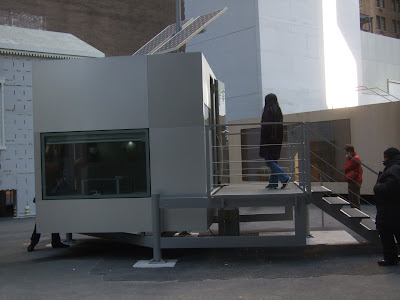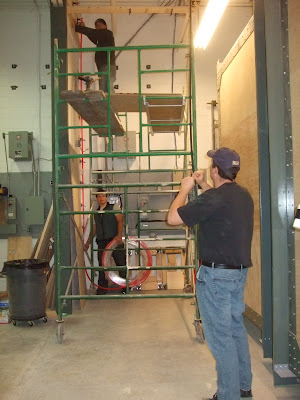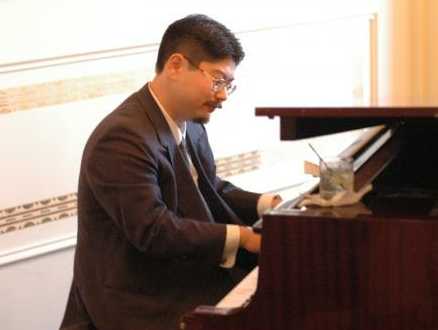A few months ago, Perlick recommended that I check out an exhibit at MoMA--
Home Delivery: Fabricating the Modern Dwelling--a survey of the history of the prefabricated home and a building project of five contemporary prefabricated houses in the Museum's Fifty-fourth street lot. I'd been hoping to catch it before it closed on October 20th (um, yeah—a bit late for a review; sorry if any of you were interested in seeing it). So here's a long Bats-style rant, in the same spirit of
previous architecture rants. Read it if you’re interested.
The exhibit is set up in two parts: the outdoor lot has five examples of contemporary prefabricated houses. Then inside, they have an exhibit on the history of prefabricated housing, going back to the 1900s (and the history timeline on the website goes back to the 1800s). I did the exhibits in that order—the outside stuff first.
The Houses (Outside)I had a variety of reactions to the various houses—from amusement, to skepticism, to appreciation of the aesthetics, to downright disdain.
The
Micro Compact Home, at 76 square feet, is a neat (and quite cute) concept.
 The project is intended as a modern "machine for living," providing functioning spaces of sleeping, working/dining, cooking and hygiene for one or two people.
The project is intended as a modern "machine for living," providing functioning spaces of sleeping, working/dining, cooking and hygiene for one or two people.
The house is constructed with a timber frame and clad in a panelized system of aluminum sheets. Following the installation of the support frame at the chosen site, the m-ch is hauled by truck or trailer and installed with a crane in minutes. … The m-ch is manufactured by micro compact home GmbH, an Austrian construction company, and is available exclusively in Europe for between €25,000 and €35,000 [$32,000 to $45,000 USD].I like the fact that they so thoroughly emphasized the “live small” philosophy, and that they were very clever about the use of space. For instance, only a short (~3 foot tall) space is available below the loft bed, but if you open up a “pit” for your legs, you can have comfortable seating. But I doubt they’ll have many takers, others than those who would alternately consider an Airstream trailer.
 System3
System3 had a few neat things going for it—I think it might have been the “least impractical” of the designs I saw. The “double wide” construction comes broken down in a single 40 foot shipping container; one “box” (with the mechanicals) is shipped whole, and the adjacent “box” is made of panels stacked on top of the first box. It is also meant not just as a two-box system—it is supposed to be stackable and arrangeable; supposedly, with CNC milling of the outside panel, it is meant to be “mass customizable.”

The aesthetics were pretty neat—blonde clearcoated wood inside and out, space age looking windows, and arrays of little soda-can side viewports. Great door hardware too; and check out their floating island kitchen.

The
Digitally-Fabricated Housing for New Orleans comes from MIT Prof Larry Sass; it is
a 196-square-foot one-room shotgun house intended as one proposal for the rapid reconstruction of New Orleans. The technology that it is based on comes from a previous project:
in an attempt to harness the speed and precision of laser cutters to fabricate simple shelters quickly and inexpensively. Joinery took the form of notches and grooves rather than traditional screws or nails. Five students, equipped only with rubber mallets, installed the first full-scale version in only two days.
It seems like a pretty neat concept, but I have doubts on what the savings might actually be. There’s more on this topic in the second part of this post, but let’s look at it two ways: materials and labor. In terms of materials, we’ve substituted sticks of wood (i.e., 2x4s, etc.) and sheathing (plywood, oriented strand board) for cleverly interlocking laser cut plywood. But there’s framing inside these digitally fabricated walls (photo shows a portion with a plexiglas skin)—in fact, a vertical and horizontal grid. Based on a quick estimate, sawn lumber and plywood are comparable on a board foot (volume) basis—so I don’t see any major material savings.

As for labor—that’s a balance of labor at the factory (and setup; capital costs of equipment, etc.), and the labor on site. A lot of these panelized systems just shift labor from the jobsite to the factory—which can be a good thing, as it’s under dry, warm, theft-resistant conditions that have great economies of scale. However, transportation costs can be the real killer—as far as I can tell, it’s
the kicker for modular housing.
However, I’ve worked on several projects that were done in New Orleans or other areas affected by Katrina. And one thing I would note, in opposition to their “knock it together with rubber hammers” argument: the reason they’re having such a rough time getting rebuilt
isn’t they’re lacking people with real hammers that drive in pointy nails. It’s that a huge portion of the population really doesn’t have much in the way of financial resources, and it seems like it’s just a naturally disorganized place. Add on top of that the fact that now they
have to build to code—i.e., changing from putting their houses on a couple of concrete blocks to a real foundation that’s meant to withstand flooding—which adds costs not previously seen in that town. Also, don't forget that the "shell" of the building is only a piece of it. They argued that student labor could put together their prototype quickly. Okay, now what about electrical, plumbing, and heating/cooling? Huh... I guess we're back to needing skilled trades to build what us folks call a "house" instead of a "shack" eh?
Also, in terms of jobsite practicalities: imagine the scenario: “Aw, crap, the forklift ran over Panel EBW-7… what do we do now?” As opposed to normal construction: “Hey, a forklift ran over [a piece of framing, a window, a door]!” “Well, crap… do another run to the lumberyard, and kick the forklift driver’s ass for me.”
Another questions, coming from a guy who makes his living looking at screwed-up buildings. So you have all those panels, with all of those joints every two or three feet, with the clever interlocking mechanisms. What's your plan for weatherproofing? Caulk? And hope? A faith-based approach to water resistance? Or are you planning for these houses to be temporary anyway? Remember,
New Orleans gets 60+ inches of rain a year.
However, I reserved a lot of my concentrated vitriol and disdain for
The Cellophane House: it got just about everything wrong, while being 100% buzzword compliant. It’s an all-glass house that’s about as energy-inefficient as you could make something, yet it has what I’ll call “sustainable window dressing”—photovoltaic panels and a solar hot water system, to make you think they’re being green. As the blurb puts it:
As designed for the exhibition Home Delivery … the house has the ability to operate entirely off-grid. Ummm, what? Maybe, if you live somewhere that never gets cold, or hot, or too much sun, or don’t mind if you get baked at 90° F, and don’t cook, or take showers at night, or use a toaster, or watch TV, or…

For a description of why I come down so hard on highly glazed buildings, see
Can Highly Glazed Building Façades Be Green?, by my advisor from UW:
When I see a fully glazed, floor-to-ceiling commercial or institutional building, I see an energy-consuming nightmare of a building that requires lots of heating and cooling at the perimeter just to maintain comfort. The result, on a cold winter day, is that offices exposed to the sun require cooling, while those in the shade need heat. Unless the control system is highly tuned, too many of the occupants will also be uncomfortable. Although it is well accepted that “green” buildings are above all low energy consumption buildings, there is a mistaken belief, almost a myth, that buildings with large expanses of glass are somehow green.
Many designers have shown that beautiful and high-performance buildings can result from a proper balance of glazing quantity and quality. All too often, however, designers appear to choose all-glass curtain walls or floor-to-ceiling strip windows because they make it easy to create a sleek impression while leaving all the tricky details in the hands of the manufacturers. How much longer can we afford to pay the energy bills that result from that choice? It’s high time to revive the craft of designing beautiful facades that don’t cost the earth.One thing I figured out recently, in my free time—windows are about the same R-value (or insulating value) as a 2x4 stud frame wall…
IF YOU LEFT OUT THE GODDAMN INSULATION. Look at Cellophane House. Think about what I wrote. Huh. If you’re curious, I’ll send you my calculations.
Other buzzword-compliant aspects—a double façade (“twice the price, half the performance”), and building-integrated solar panels. Specifically, one of the walls has PV panels built in. So what’s wrong with that?

Well, you want to face solar panels around an angle equal to your latitude—which suggests that the right spot for a solar panel is the roof, or say, the part of the building that
FACES THE FRIGGIN’ SKY. A quick calculation shows that going from the optimal solar angle (latitude) to a vertical orientation drops you to 2/3 of your possible solar production. And that’s assuming that your walls are never shaded… say, by trees or uh,
adjacent buildings… another argument for using the roof (see sky, facing, friggin’). Considering how expensive PVs are, it’s a huge waste of money and resources to lose 1/3 of your production, off the bat, due to your poor design. As one of my friends who works for a solar design company puts it, “Man… on some of these architectural jobs, they would probably be much better off putting blue glass on the side of the building, and taking the money they saved and dumping it into clean power credits.”
Another instance of full-of-buzzwords-piss-me-off: the architects note that the design
…makes no claims to permanence. The structural frame of the house is made entirely of off-the-shelf structural aluminum, upon which materials are collected rather than fixed. This allows the materials not only to retain their identity as discrete elements, but also to be disassembled instead of demolished, and eventually to be recycled instead of wasted. First of all, the way they detail it, the aluminum forms a horrible thermal bridge between the inside and outside, bleeding off heat in the winter… although they really don’t have insulation, so it doesn’t matter that much. But claiming environmental points for using aluminum that you can disassemble and reuse (
aluminum has an insanely high embodied energy--the energy required to make the product) is an embarrassment. It’s like an arsonist claiming credit for helping put out the fire he started (not my analogy—
Maureen Dowd’s jab at McCain crowing about the troop surge).
Another examples--a building shell that's an energy sieve--"... but hey, we have LED lights! Isn't that great!" Oy.

Yes, yes, I know, I should back off—“This is supposed to be art, not necessarily where somebody would live, or an engineering showcase.” And yes, it looks really cool—no argument from me there.
But is it sustainable, serviceable, or livable?—I think you can guess my view. Also, will other architects or consumers look at this building, and say, “Hey, cool, I want a neat building like this—plus it has solar panels, it must be energy efficient!” I just worry that people who don’t know better will be learning the wrong lesson.
The Exhibit (Inside)The inside exhibit showed examples of prefabricated housing back to the 1930’s, and the history traces back further to the industrial revolution. Lot of great displays—Bucky Fuller’s
Dymaxion House,
Thomas Edison’s single pour concrete house, Moishe Safdie’s
Habitat 67, and lots of works by other famous name architects. Also, some cool shipping container projects.
But there was one striking refrain throughout the exhibit that made me a bit reflective. Almost all of them made statements along the lines of, “…with the efficiencies we are introducing with these factory-built houses, we will bring down the cost of housing; they will be mass-produced everywhere, and we will bring houses to everyone.” However, it seems like these predictions—over many decades—have mostly fallen on their face—which makes me suspicious of anyone who makes such a claim nowadays.
Now, of course, I’ll admit that there are exceptions—if you take a Darwinian view, and see what actually is surviving or thriving in the market today, you’ll see examples like the following, where prefabricated houses are fulfilling a certain need, as opposed to taking over the general market:
- Modular construction (i.e., boxes on trailers that get put together on site) are a small but non-insignificant portion of the homebuilding industry.
- Quonset huts--they filled a specific niche, but did it very well: In 1941 the United States Navy needed an all-purpose, lightweight building that could be shipped anywhere and assembled without skilled labor.
- Prefabricated components (such as roof trusses, or windows and doors—things that make more economic sense to build off-site, instead of with site labor).
- Panelized construction (such as pre-built wall or floor panels, or higher-tech solution like structural insulated panel system (SIPS). SIPS has a similar refrain—we’ll save money. With SIPS construction, you can get a superior, quickly dried in, very airtight, and well insulated house. But unfortunately for the SIPS guys, site/stick built construction is at a pretty darn low price point that’s really difficult to beat.
Another aspect of both the outdoor and indoor exhibits: most of them used base materials that were intrinsically more expensive, such as aluminum panels, or clearcoated wood. I’ll fully admit, these are sexy finishes, for sure—but very few things beat the cost of pieces of wood. Add the problems mentioned before (transportation costs), as well as the reduced on-site flexibility (“What, panel six is a foot too short? And it’s our fault because our drawings were wrong? Crap!”) Add to that the fact that all the modular assembly mechanisms—as clever as the engineering is—often add cost, by requiring connection hardware, crane use for installation, etc.
As a bottom line—maybe the day will come when prefabricated housing takes over the industry—and it might be a very good thing, given the problems I see in site-built construction. Maybe digital prototyping on a production housing scale will save us all. But I don’t think it’s likely to happen. Okay… maybe if we get houses sent to us from China in shipping containers… but that’s an ugly idea for all sorts of other reasons.












































